Global Business Environment: Analyzing Sasol's Operations
VerifiedAdded on 2023/06/09
|13
|3815
|423
Report
AI Summary
This report provides a detailed analysis of Sasol, a multinational chemical and energy company, examining its operations within the global business environment. The report begins with an introduction to Sasol, highlighting its core business and purpose. It then delves into a task-based structure, utilizing the McKinsey 7s model to analyze Sasol's culture, structure, and governance. The report investigates factors influencing Sasol's operations, including legal and technological considerations, as well as the impact of customers and suppliers. The report examines how Sasol has adapted to the global market, followed by an application of Hofstede's Dimensions of Culture to demonstrate cultural influences. Furthermore, it evaluates ethical and sustainable factors crucial for Sasol's global presence, and critically assesses strategic decision-making concerning risk and diversification. Finally, it assesses the range of strategic global expansion routes available to the organization. The report concludes with a summary of the key findings and a list of references.
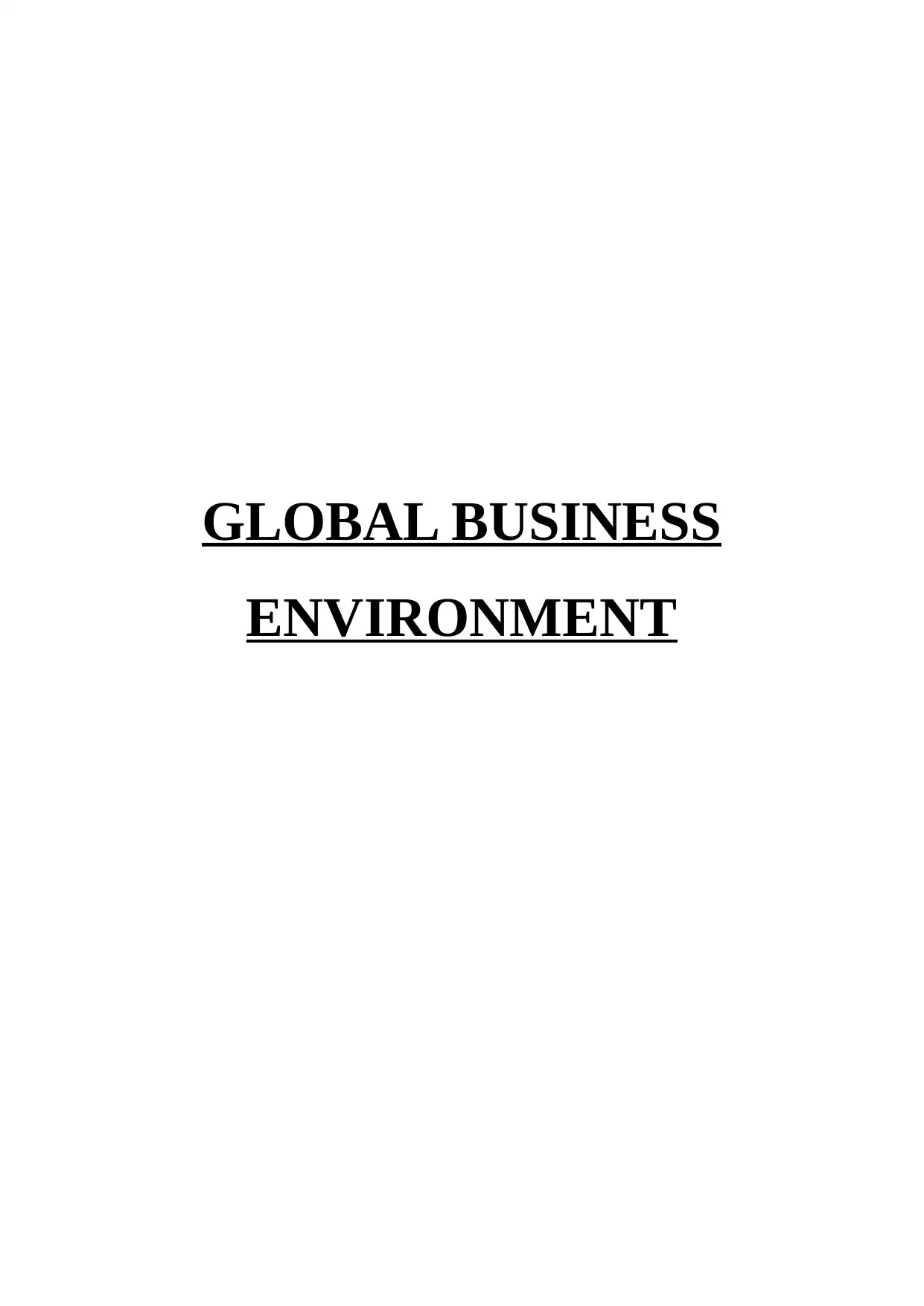
GLOBAL BUSINESS
ENVIRONMENT
ENVIRONMENT
Paraphrase This Document
Need a fresh take? Get an instant paraphrase of this document with our AI Paraphraser
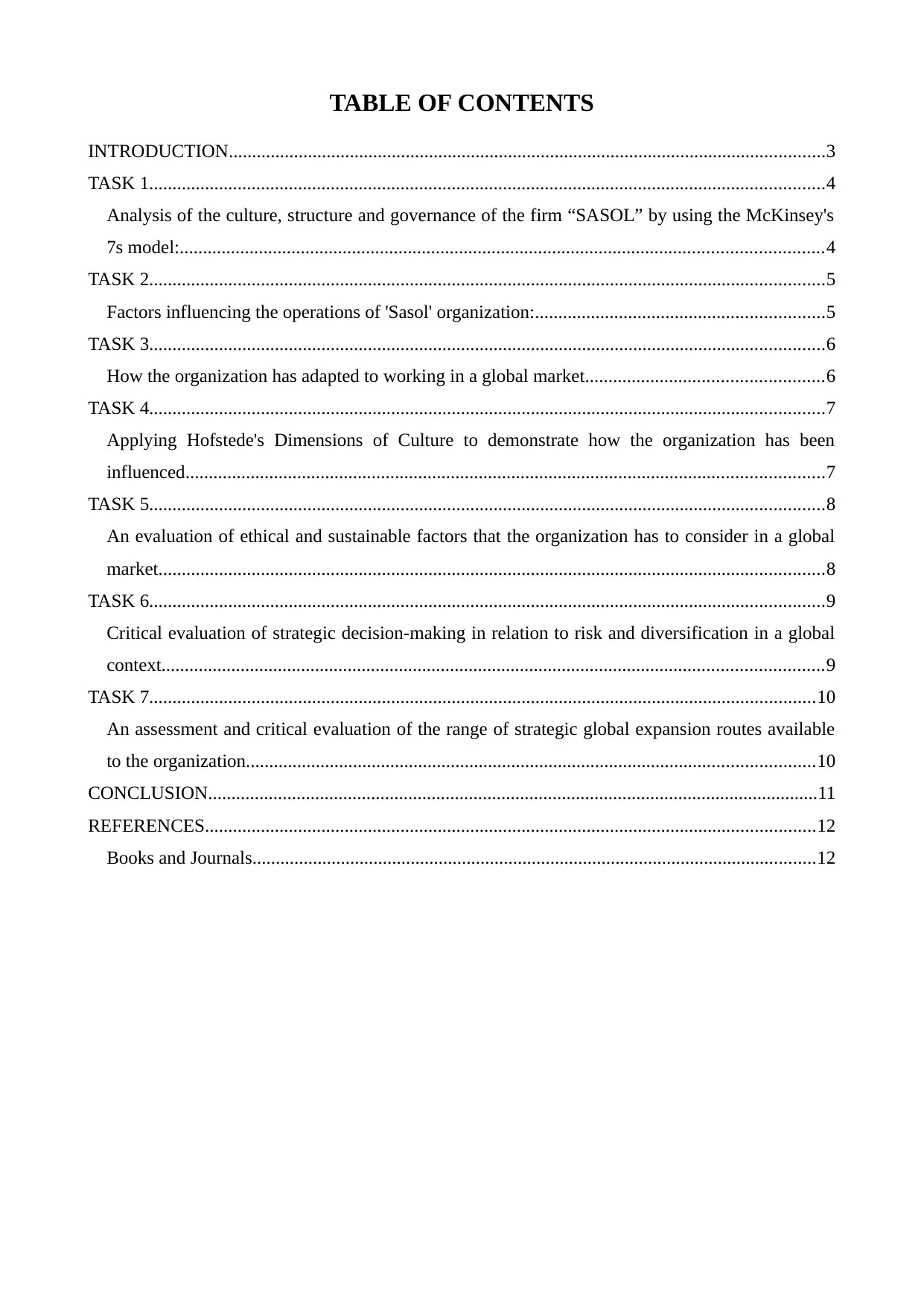
TABLE OF CONTENTS
INTRODUCTION................................................................................................................................3
TASK 1.................................................................................................................................................4
Analysis of the culture, structure and governance of the firm “SASOL” by using the McKinsey's
7s model:..........................................................................................................................................4
TASK 2.................................................................................................................................................5
Factors influencing the operations of 'Sasol' organization:..............................................................5
TASK 3.................................................................................................................................................6
How the organization has adapted to working in a global market...................................................6
TASK 4.................................................................................................................................................7
Applying Hofstede's Dimensions of Culture to demonstrate how the organization has been
influenced.........................................................................................................................................7
TASK 5.................................................................................................................................................8
An evaluation of ethical and sustainable factors that the organization has to consider in a global
market...............................................................................................................................................8
TASK 6.................................................................................................................................................9
Critical evaluation of strategic decision-making in relation to risk and diversification in a global
context..............................................................................................................................................9
TASK 7...............................................................................................................................................10
An assessment and critical evaluation of the range of strategic global expansion routes available
to the organization..........................................................................................................................10
CONCLUSION...................................................................................................................................11
REFERENCES...................................................................................................................................12
Books and Journals.........................................................................................................................12
INTRODUCTION................................................................................................................................3
TASK 1.................................................................................................................................................4
Analysis of the culture, structure and governance of the firm “SASOL” by using the McKinsey's
7s model:..........................................................................................................................................4
TASK 2.................................................................................................................................................5
Factors influencing the operations of 'Sasol' organization:..............................................................5
TASK 3.................................................................................................................................................6
How the organization has adapted to working in a global market...................................................6
TASK 4.................................................................................................................................................7
Applying Hofstede's Dimensions of Culture to demonstrate how the organization has been
influenced.........................................................................................................................................7
TASK 5.................................................................................................................................................8
An evaluation of ethical and sustainable factors that the organization has to consider in a global
market...............................................................................................................................................8
TASK 6.................................................................................................................................................9
Critical evaluation of strategic decision-making in relation to risk and diversification in a global
context..............................................................................................................................................9
TASK 7...............................................................................................................................................10
An assessment and critical evaluation of the range of strategic global expansion routes available
to the organization..........................................................................................................................10
CONCLUSION...................................................................................................................................11
REFERENCES...................................................................................................................................12
Books and Journals.........................................................................................................................12
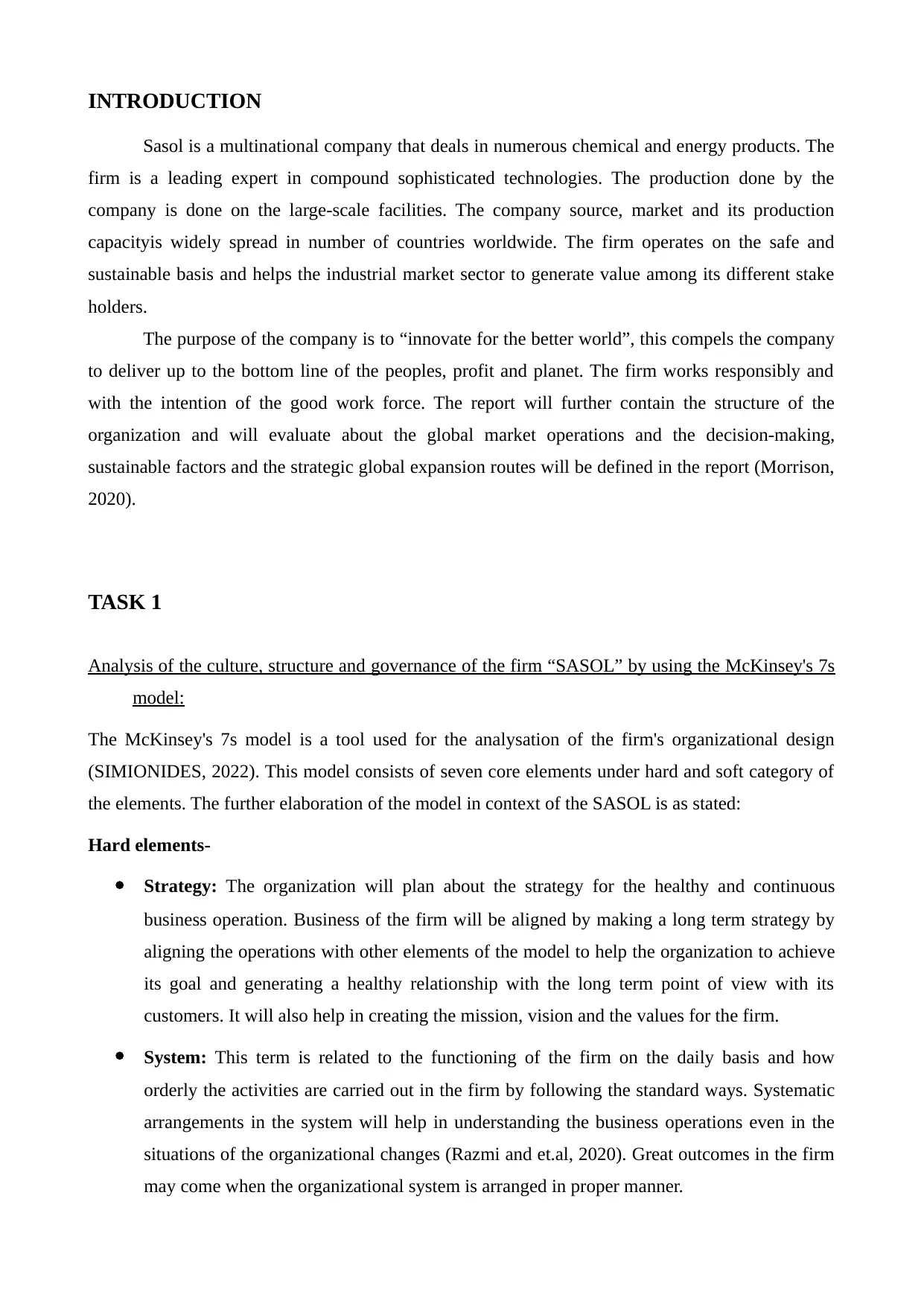
INTRODUCTION
Sasol is a multinational company that deals in numerous chemical and energy products. The
firm is a leading expert in compound sophisticated technologies. The production done by the
company is done on the large-scale facilities. The company source, market and its production
capacityis widely spread in number of countries worldwide. The firm operates on the safe and
sustainable basis and helps the industrial market sector to generate value among its different stake
holders.
The purpose of the company is to “innovate for the better world”, this compels the company
to deliver up to the bottom line of the peoples, profit and planet. The firm works responsibly and
with the intention of the good work force. The report will further contain the structure of the
organization and will evaluate about the global market operations and the decision-making,
sustainable factors and the strategic global expansion routes will be defined in the report (Morrison,
2020).
TASK 1
Analysis of the culture, structure and governance of the firm “SASOL” by using the McKinsey's 7s
model:
The McKinsey's 7s model is a tool used for the analysation of the firm's organizational design
(SIMIONIDES, 2022). This model consists of seven core elements under hard and soft category of
the elements. The further elaboration of the model in context of the SASOL is as stated:
Hard elements-
Strategy: The organization will plan about the strategy for the healthy and continuous
business operation. Business of the firm will be aligned by making a long term strategy by
aligning the operations with other elements of the model to help the organization to achieve
its goal and generating a healthy relationship with the long term point of view with its
customers. It will also help in creating the mission, vision and the values for the firm.
System: This term is related to the functioning of the firm on the daily basis and how
orderly the activities are carried out in the firm by following the standard ways. Systematic
arrangements in the system will help in understanding the business operations even in the
situations of the organizational changes (Razmi and et.al, 2020). Great outcomes in the firm
may come when the organizational system is arranged in proper manner.
Sasol is a multinational company that deals in numerous chemical and energy products. The
firm is a leading expert in compound sophisticated technologies. The production done by the
company is done on the large-scale facilities. The company source, market and its production
capacityis widely spread in number of countries worldwide. The firm operates on the safe and
sustainable basis and helps the industrial market sector to generate value among its different stake
holders.
The purpose of the company is to “innovate for the better world”, this compels the company
to deliver up to the bottom line of the peoples, profit and planet. The firm works responsibly and
with the intention of the good work force. The report will further contain the structure of the
organization and will evaluate about the global market operations and the decision-making,
sustainable factors and the strategic global expansion routes will be defined in the report (Morrison,
2020).
TASK 1
Analysis of the culture, structure and governance of the firm “SASOL” by using the McKinsey's 7s
model:
The McKinsey's 7s model is a tool used for the analysation of the firm's organizational design
(SIMIONIDES, 2022). This model consists of seven core elements under hard and soft category of
the elements. The further elaboration of the model in context of the SASOL is as stated:
Hard elements-
Strategy: The organization will plan about the strategy for the healthy and continuous
business operation. Business of the firm will be aligned by making a long term strategy by
aligning the operations with other elements of the model to help the organization to achieve
its goal and generating a healthy relationship with the long term point of view with its
customers. It will also help in creating the mission, vision and the values for the firm.
System: This term is related to the functioning of the firm on the daily basis and how
orderly the activities are carried out in the firm by following the standard ways. Systematic
arrangements in the system will help in understanding the business operations even in the
situations of the organizational changes (Razmi and et.al, 2020). Great outcomes in the firm
may come when the organizational system is arranged in proper manner.
⊘ This is a preview!⊘
Do you want full access?
Subscribe today to unlock all pages.

Trusted by 1+ million students worldwide
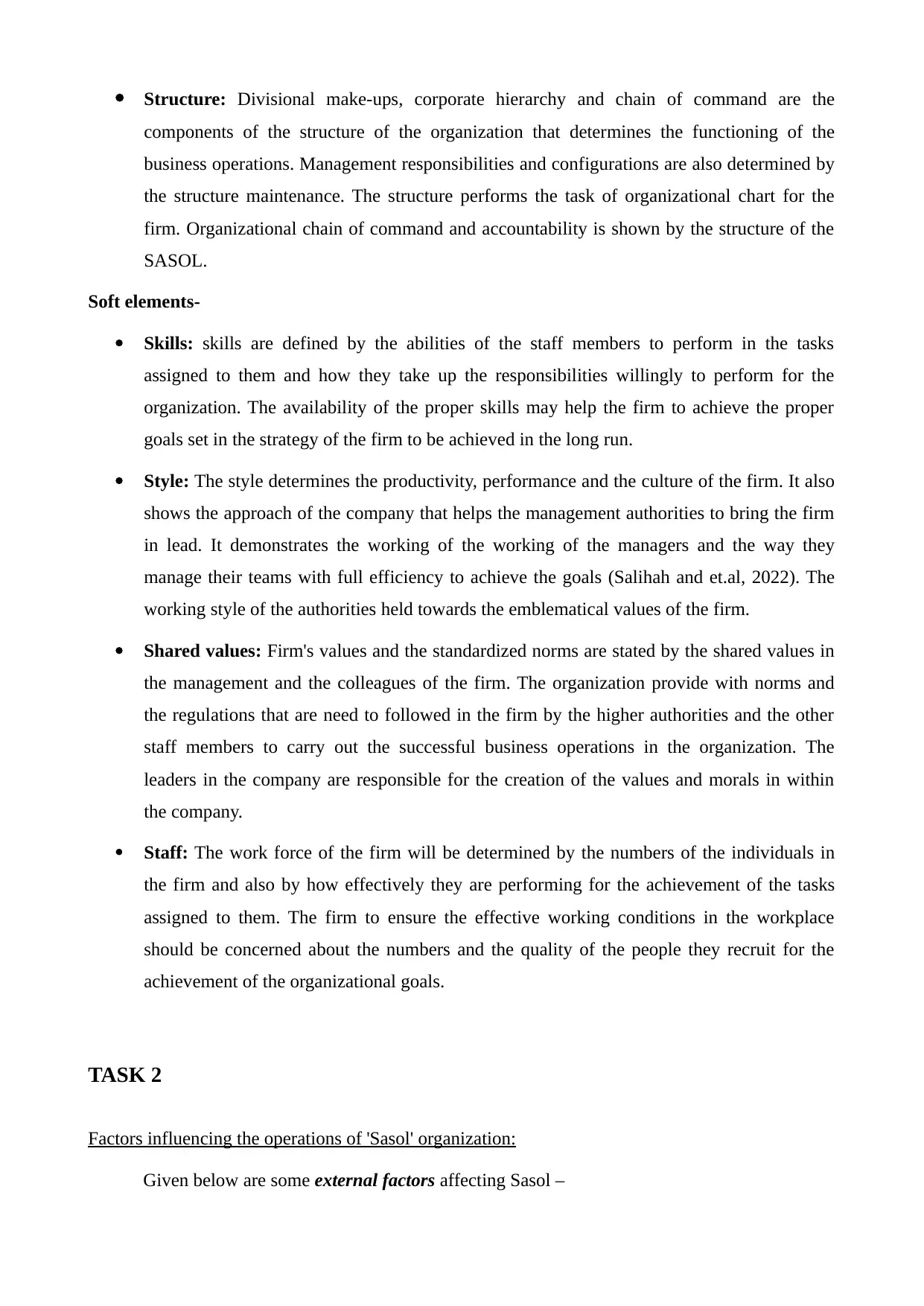
Structure: Divisional make-ups, corporate hierarchy and chain of command are the
components of the structure of the organization that determines the functioning of the
business operations. Management responsibilities and configurations are also determined by
the structure maintenance. The structure performs the task of organizational chart for the
firm. Organizational chain of command and accountability is shown by the structure of the
SASOL.
Soft elements-
Skills: skills are defined by the abilities of the staff members to perform in the tasks
assigned to them and how they take up the responsibilities willingly to perform for the
organization. The availability of the proper skills may help the firm to achieve the proper
goals set in the strategy of the firm to be achieved in the long run.
Style: The style determines the productivity, performance and the culture of the firm. It also
shows the approach of the company that helps the management authorities to bring the firm
in lead. It demonstrates the working of the working of the managers and the way they
manage their teams with full efficiency to achieve the goals (Salihah and et.al, 2022). The
working style of the authorities held towards the emblematical values of the firm.
Shared values: Firm's values and the standardized norms are stated by the shared values in
the management and the colleagues of the firm. The organization provide with norms and
the regulations that are need to followed in the firm by the higher authorities and the other
staff members to carry out the successful business operations in the organization. The
leaders in the company are responsible for the creation of the values and morals in within
the company.
Staff: The work force of the firm will be determined by the numbers of the individuals in
the firm and also by how effectively they are performing for the achievement of the tasks
assigned to them. The firm to ensure the effective working conditions in the workplace
should be concerned about the numbers and the quality of the people they recruit for the
achievement of the organizational goals.
TASK 2
Factors influencing the operations of 'Sasol' organization:
Given below are some external factors affecting Sasol –
components of the structure of the organization that determines the functioning of the
business operations. Management responsibilities and configurations are also determined by
the structure maintenance. The structure performs the task of organizational chart for the
firm. Organizational chain of command and accountability is shown by the structure of the
SASOL.
Soft elements-
Skills: skills are defined by the abilities of the staff members to perform in the tasks
assigned to them and how they take up the responsibilities willingly to perform for the
organization. The availability of the proper skills may help the firm to achieve the proper
goals set in the strategy of the firm to be achieved in the long run.
Style: The style determines the productivity, performance and the culture of the firm. It also
shows the approach of the company that helps the management authorities to bring the firm
in lead. It demonstrates the working of the working of the managers and the way they
manage their teams with full efficiency to achieve the goals (Salihah and et.al, 2022). The
working style of the authorities held towards the emblematical values of the firm.
Shared values: Firm's values and the standardized norms are stated by the shared values in
the management and the colleagues of the firm. The organization provide with norms and
the regulations that are need to followed in the firm by the higher authorities and the other
staff members to carry out the successful business operations in the organization. The
leaders in the company are responsible for the creation of the values and morals in within
the company.
Staff: The work force of the firm will be determined by the numbers of the individuals in
the firm and also by how effectively they are performing for the achievement of the tasks
assigned to them. The firm to ensure the effective working conditions in the workplace
should be concerned about the numbers and the quality of the people they recruit for the
achievement of the organizational goals.
TASK 2
Factors influencing the operations of 'Sasol' organization:
Given below are some external factors affecting Sasol –
Paraphrase This Document
Need a fresh take? Get an instant paraphrase of this document with our AI Paraphraser
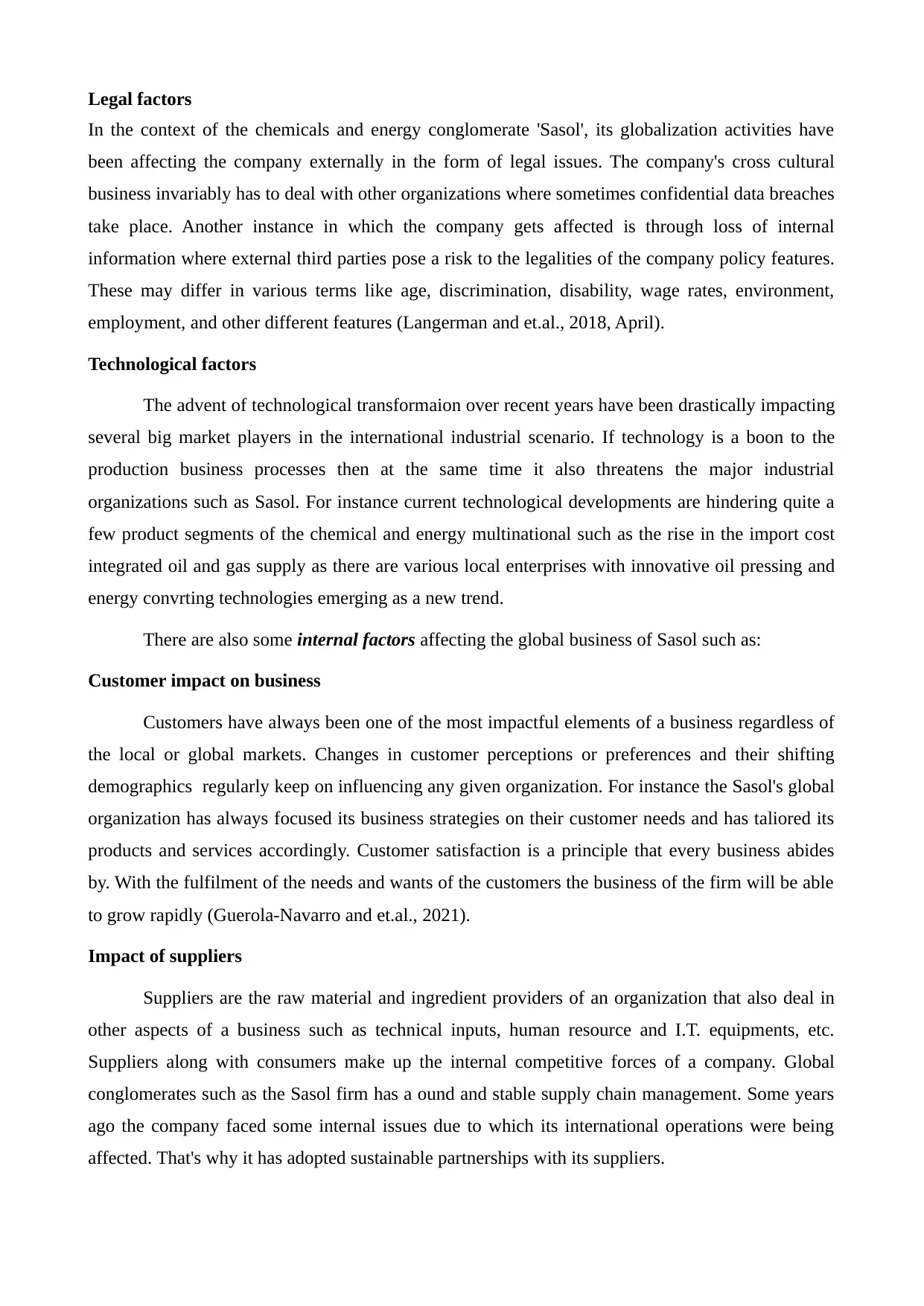
Legal factors
In the context of the chemicals and energy conglomerate 'Sasol', its globalization activities have
been affecting the company externally in the form of legal issues. The company's cross cultural
business invariably has to deal with other organizations where sometimes confidential data breaches
take place. Another instance in which the company gets affected is through loss of internal
information where external third parties pose a risk to the legalities of the company policy features.
These may differ in various terms like age, discrimination, disability, wage rates, environment,
employment, and other different features (Langerman and et.al., 2018, April).
Technological factors
The advent of technological transformaion over recent years have been drastically impacting
several big market players in the international industrial scenario. If technology is a boon to the
production business processes then at the same time it also threatens the major industrial
organizations such as Sasol. For instance current technological developments are hindering quite a
few product segments of the chemical and energy multinational such as the rise in the import cost
integrated oil and gas supply as there are various local enterprises with innovative oil pressing and
energy convrting technologies emerging as a new trend.
There are also some internal factors affecting the global business of Sasol such as:
Customer impact on business
Customers have always been one of the most impactful elements of a business regardless of
the local or global markets. Changes in customer perceptions or preferences and their shifting
demographics regularly keep on influencing any given organization. For instance the Sasol's global
organization has always focused its business strategies on their customer needs and has taliored its
products and services accordingly. Customer satisfaction is a principle that every business abides
by. With the fulfilment of the needs and wants of the customers the business of the firm will be able
to grow rapidly (Guerola-Navarro and et.al., 2021).
Impact of suppliers
Suppliers are the raw material and ingredient providers of an organization that also deal in
other aspects of a business such as technical inputs, human resource and I.T. equipments, etc.
Suppliers along with consumers make up the internal competitive forces of a company. Global
conglomerates such as the Sasol firm has a ound and stable supply chain management. Some years
ago the company faced some internal issues due to which its international operations were being
affected. That's why it has adopted sustainable partnerships with its suppliers.
In the context of the chemicals and energy conglomerate 'Sasol', its globalization activities have
been affecting the company externally in the form of legal issues. The company's cross cultural
business invariably has to deal with other organizations where sometimes confidential data breaches
take place. Another instance in which the company gets affected is through loss of internal
information where external third parties pose a risk to the legalities of the company policy features.
These may differ in various terms like age, discrimination, disability, wage rates, environment,
employment, and other different features (Langerman and et.al., 2018, April).
Technological factors
The advent of technological transformaion over recent years have been drastically impacting
several big market players in the international industrial scenario. If technology is a boon to the
production business processes then at the same time it also threatens the major industrial
organizations such as Sasol. For instance current technological developments are hindering quite a
few product segments of the chemical and energy multinational such as the rise in the import cost
integrated oil and gas supply as there are various local enterprises with innovative oil pressing and
energy convrting technologies emerging as a new trend.
There are also some internal factors affecting the global business of Sasol such as:
Customer impact on business
Customers have always been one of the most impactful elements of a business regardless of
the local or global markets. Changes in customer perceptions or preferences and their shifting
demographics regularly keep on influencing any given organization. For instance the Sasol's global
organization has always focused its business strategies on their customer needs and has taliored its
products and services accordingly. Customer satisfaction is a principle that every business abides
by. With the fulfilment of the needs and wants of the customers the business of the firm will be able
to grow rapidly (Guerola-Navarro and et.al., 2021).
Impact of suppliers
Suppliers are the raw material and ingredient providers of an organization that also deal in
other aspects of a business such as technical inputs, human resource and I.T. equipments, etc.
Suppliers along with consumers make up the internal competitive forces of a company. Global
conglomerates such as the Sasol firm has a ound and stable supply chain management. Some years
ago the company faced some internal issues due to which its international operations were being
affected. That's why it has adopted sustainable partnerships with its suppliers.
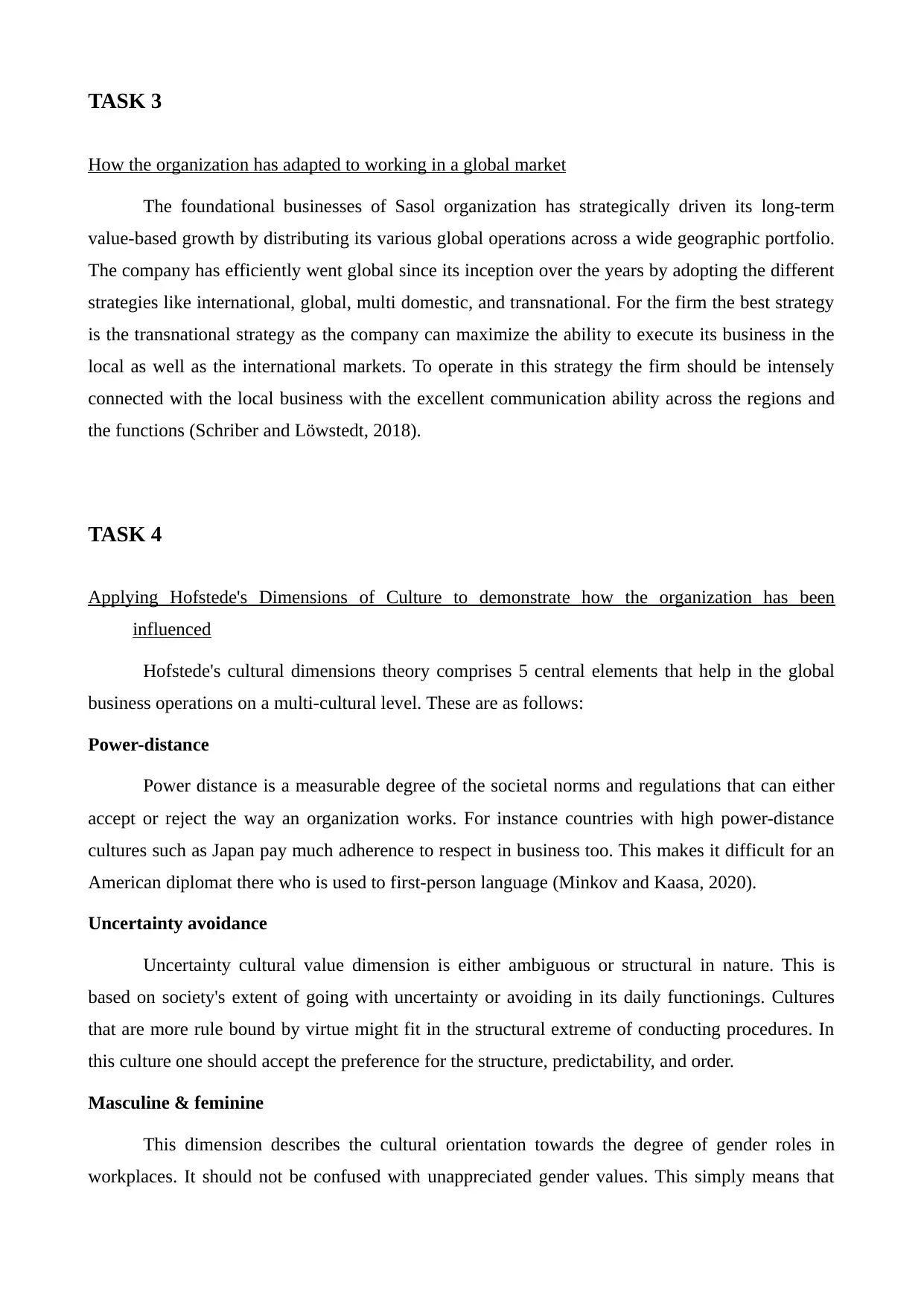
TASK 3
How the organization has adapted to working in a global market
The foundational businesses of Sasol organization has strategically driven its long-term
value-based growth by distributing its various global operations across a wide geographic portfolio.
The company has efficiently went global since its inception over the years by adopting the different
strategies like international, global, multi domestic, and transnational. For the firm the best strategy
is the transnational strategy as the company can maximize the ability to execute its business in the
local as well as the international markets. To operate in this strategy the firm should be intensely
connected with the local business with the excellent communication ability across the regions and
the functions (Schriber and Löwstedt, 2018).
TASK 4
Applying Hofstede's Dimensions of Culture to demonstrate how the organization has been
influenced
Hofstede's cultural dimensions theory comprises 5 central elements that help in the global
business operations on a multi-cultural level. These are as follows:
Power-distance
Power distance is a measurable degree of the societal norms and regulations that can either
accept or reject the way an organization works. For instance countries with high power-distance
cultures such as Japan pay much adherence to respect in business too. This makes it difficult for an
American diplomat there who is used to first-person language (Minkov and Kaasa, 2020).
Uncertainty avoidance
Uncertainty cultural value dimension is either ambiguous or structural in nature. This is
based on society's extent of going with uncertainty or avoiding in its daily functionings. Cultures
that are more rule bound by virtue might fit in the structural extreme of conducting procedures. In
this culture one should accept the preference for the structure, predictability, and order.
Masculine & feminine
This dimension describes the cultural orientation towards the degree of gender roles in
workplaces. It should not be confused with unappreciated gender values. This simply means that
How the organization has adapted to working in a global market
The foundational businesses of Sasol organization has strategically driven its long-term
value-based growth by distributing its various global operations across a wide geographic portfolio.
The company has efficiently went global since its inception over the years by adopting the different
strategies like international, global, multi domestic, and transnational. For the firm the best strategy
is the transnational strategy as the company can maximize the ability to execute its business in the
local as well as the international markets. To operate in this strategy the firm should be intensely
connected with the local business with the excellent communication ability across the regions and
the functions (Schriber and Löwstedt, 2018).
TASK 4
Applying Hofstede's Dimensions of Culture to demonstrate how the organization has been
influenced
Hofstede's cultural dimensions theory comprises 5 central elements that help in the global
business operations on a multi-cultural level. These are as follows:
Power-distance
Power distance is a measurable degree of the societal norms and regulations that can either
accept or reject the way an organization works. For instance countries with high power-distance
cultures such as Japan pay much adherence to respect in business too. This makes it difficult for an
American diplomat there who is used to first-person language (Minkov and Kaasa, 2020).
Uncertainty avoidance
Uncertainty cultural value dimension is either ambiguous or structural in nature. This is
based on society's extent of going with uncertainty or avoiding in its daily functionings. Cultures
that are more rule bound by virtue might fit in the structural extreme of conducting procedures. In
this culture one should accept the preference for the structure, predictability, and order.
Masculine & feminine
This dimension describes the cultural orientation towards the degree of gender roles in
workplaces. It should not be confused with unappreciated gender values. This simply means that
⊘ This is a preview!⊘
Do you want full access?
Subscribe today to unlock all pages.

Trusted by 1+ million students worldwide
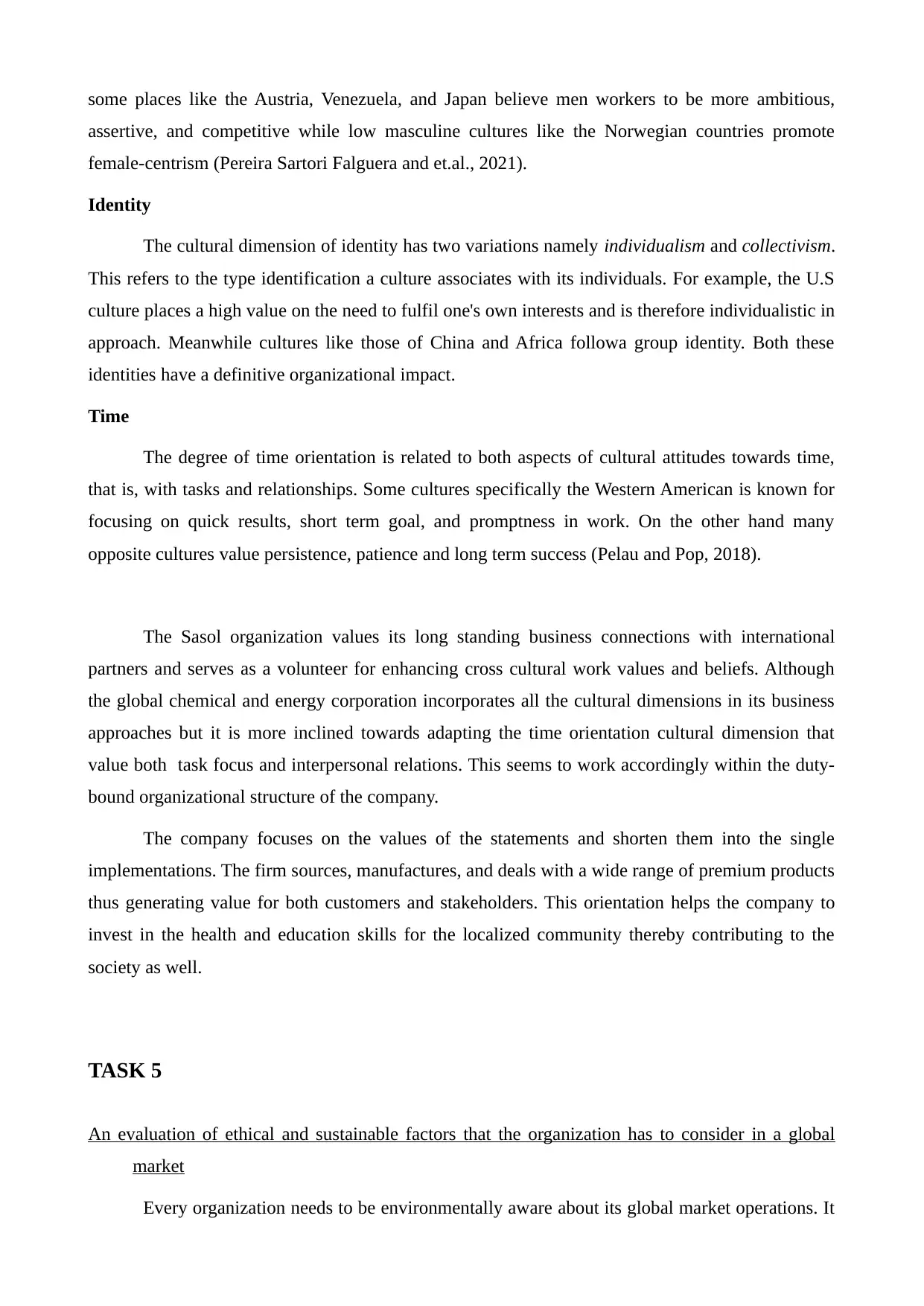
some places like the Austria, Venezuela, and Japan believe men workers to be more ambitious,
assertive, and competitive while low masculine cultures like the Norwegian countries promote
female-centrism (Pereira Sartori Falguera and et.al., 2021).
Identity
The cultural dimension of identity has two variations namely individualism and collectivism.
This refers to the type identification a culture associates with its individuals. For example, the U.S
culture places a high value on the need to fulfil one's own interests and is therefore individualistic in
approach. Meanwhile cultures like those of China and Africa followa group identity. Both these
identities have a definitive organizational impact.
Time
The degree of time orientation is related to both aspects of cultural attitudes towards time,
that is, with tasks and relationships. Some cultures specifically the Western American is known for
focusing on quick results, short term goal, and promptness in work. On the other hand many
opposite cultures value persistence, patience and long term success (Pelau and Pop, 2018).
The Sasol organization values its long standing business connections with international
partners and serves as a volunteer for enhancing cross cultural work values and beliefs. Although
the global chemical and energy corporation incorporates all the cultural dimensions in its business
approaches but it is more inclined towards adapting the time orientation cultural dimension that
value both task focus and interpersonal relations. This seems to work accordingly within the duty-
bound organizational structure of the company.
The company focuses on the values of the statements and shorten them into the single
implementations. The firm sources, manufactures, and deals with a wide range of premium products
thus generating value for both customers and stakeholders. This orientation helps the company to
invest in the health and education skills for the localized community thereby contributing to the
society as well.
TASK 5
An evaluation of ethical and sustainable factors that the organization has to consider in a global
market
Every organization needs to be environmentally aware about its global market operations. It
assertive, and competitive while low masculine cultures like the Norwegian countries promote
female-centrism (Pereira Sartori Falguera and et.al., 2021).
Identity
The cultural dimension of identity has two variations namely individualism and collectivism.
This refers to the type identification a culture associates with its individuals. For example, the U.S
culture places a high value on the need to fulfil one's own interests and is therefore individualistic in
approach. Meanwhile cultures like those of China and Africa followa group identity. Both these
identities have a definitive organizational impact.
Time
The degree of time orientation is related to both aspects of cultural attitudes towards time,
that is, with tasks and relationships. Some cultures specifically the Western American is known for
focusing on quick results, short term goal, and promptness in work. On the other hand many
opposite cultures value persistence, patience and long term success (Pelau and Pop, 2018).
The Sasol organization values its long standing business connections with international
partners and serves as a volunteer for enhancing cross cultural work values and beliefs. Although
the global chemical and energy corporation incorporates all the cultural dimensions in its business
approaches but it is more inclined towards adapting the time orientation cultural dimension that
value both task focus and interpersonal relations. This seems to work accordingly within the duty-
bound organizational structure of the company.
The company focuses on the values of the statements and shorten them into the single
implementations. The firm sources, manufactures, and deals with a wide range of premium products
thus generating value for both customers and stakeholders. This orientation helps the company to
invest in the health and education skills for the localized community thereby contributing to the
society as well.
TASK 5
An evaluation of ethical and sustainable factors that the organization has to consider in a global
market
Every organization needs to be environmentally aware about its global market operations. It
Paraphrase This Document
Need a fresh take? Get an instant paraphrase of this document with our AI Paraphraser
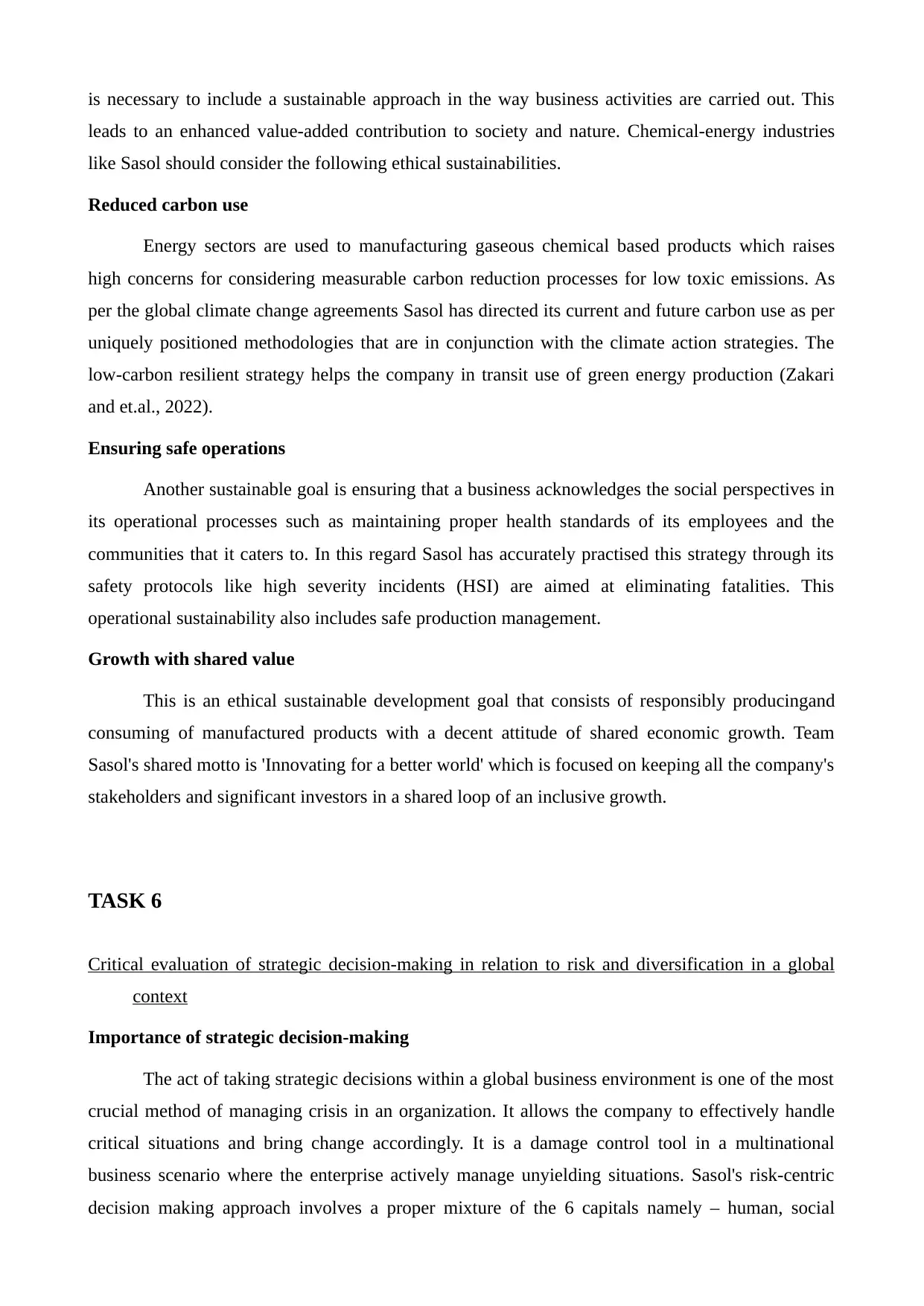
is necessary to include a sustainable approach in the way business activities are carried out. This
leads to an enhanced value-added contribution to society and nature. Chemical-energy industries
like Sasol should consider the following ethical sustainabilities.
Reduced carbon use
Energy sectors are used to manufacturing gaseous chemical based products which raises
high concerns for considering measurable carbon reduction processes for low toxic emissions. As
per the global climate change agreements Sasol has directed its current and future carbon use as per
uniquely positioned methodologies that are in conjunction with the climate action strategies. The
low-carbon resilient strategy helps the company in transit use of green energy production (Zakari
and et.al., 2022).
Ensuring safe operations
Another sustainable goal is ensuring that a business acknowledges the social perspectives in
its operational processes such as maintaining proper health standards of its employees and the
communities that it caters to. In this regard Sasol has accurately practised this strategy through its
safety protocols like high severity incidents (HSI) are aimed at eliminating fatalities. This
operational sustainability also includes safe production management.
Growth with shared value
This is an ethical sustainable development goal that consists of responsibly producingand
consuming of manufactured products with a decent attitude of shared economic growth. Team
Sasol's shared motto is 'Innovating for a better world' which is focused on keeping all the company's
stakeholders and significant investors in a shared loop of an inclusive growth.
TASK 6
Critical evaluation of strategic decision-making in relation to risk and diversification in a global
context
Importance of strategic decision-making
The act of taking strategic decisions within a global business environment is one of the most
crucial method of managing crisis in an organization. It allows the company to effectively handle
critical situations and bring change accordingly. It is a damage control tool in a multinational
business scenario where the enterprise actively manage unyielding situations. Sasol's risk-centric
decision making approach involves a proper mixture of the 6 capitals namely – human, social
leads to an enhanced value-added contribution to society and nature. Chemical-energy industries
like Sasol should consider the following ethical sustainabilities.
Reduced carbon use
Energy sectors are used to manufacturing gaseous chemical based products which raises
high concerns for considering measurable carbon reduction processes for low toxic emissions. As
per the global climate change agreements Sasol has directed its current and future carbon use as per
uniquely positioned methodologies that are in conjunction with the climate action strategies. The
low-carbon resilient strategy helps the company in transit use of green energy production (Zakari
and et.al., 2022).
Ensuring safe operations
Another sustainable goal is ensuring that a business acknowledges the social perspectives in
its operational processes such as maintaining proper health standards of its employees and the
communities that it caters to. In this regard Sasol has accurately practised this strategy through its
safety protocols like high severity incidents (HSI) are aimed at eliminating fatalities. This
operational sustainability also includes safe production management.
Growth with shared value
This is an ethical sustainable development goal that consists of responsibly producingand
consuming of manufactured products with a decent attitude of shared economic growth. Team
Sasol's shared motto is 'Innovating for a better world' which is focused on keeping all the company's
stakeholders and significant investors in a shared loop of an inclusive growth.
TASK 6
Critical evaluation of strategic decision-making in relation to risk and diversification in a global
context
Importance of strategic decision-making
The act of taking strategic decisions within a global business environment is one of the most
crucial method of managing crisis in an organization. It allows the company to effectively handle
critical situations and bring change accordingly. It is a damage control tool in a multinational
business scenario where the enterprise actively manage unyielding situations. Sasol's risk-centric
decision making approach involves a proper mixture of the 6 capitals namely – human, social
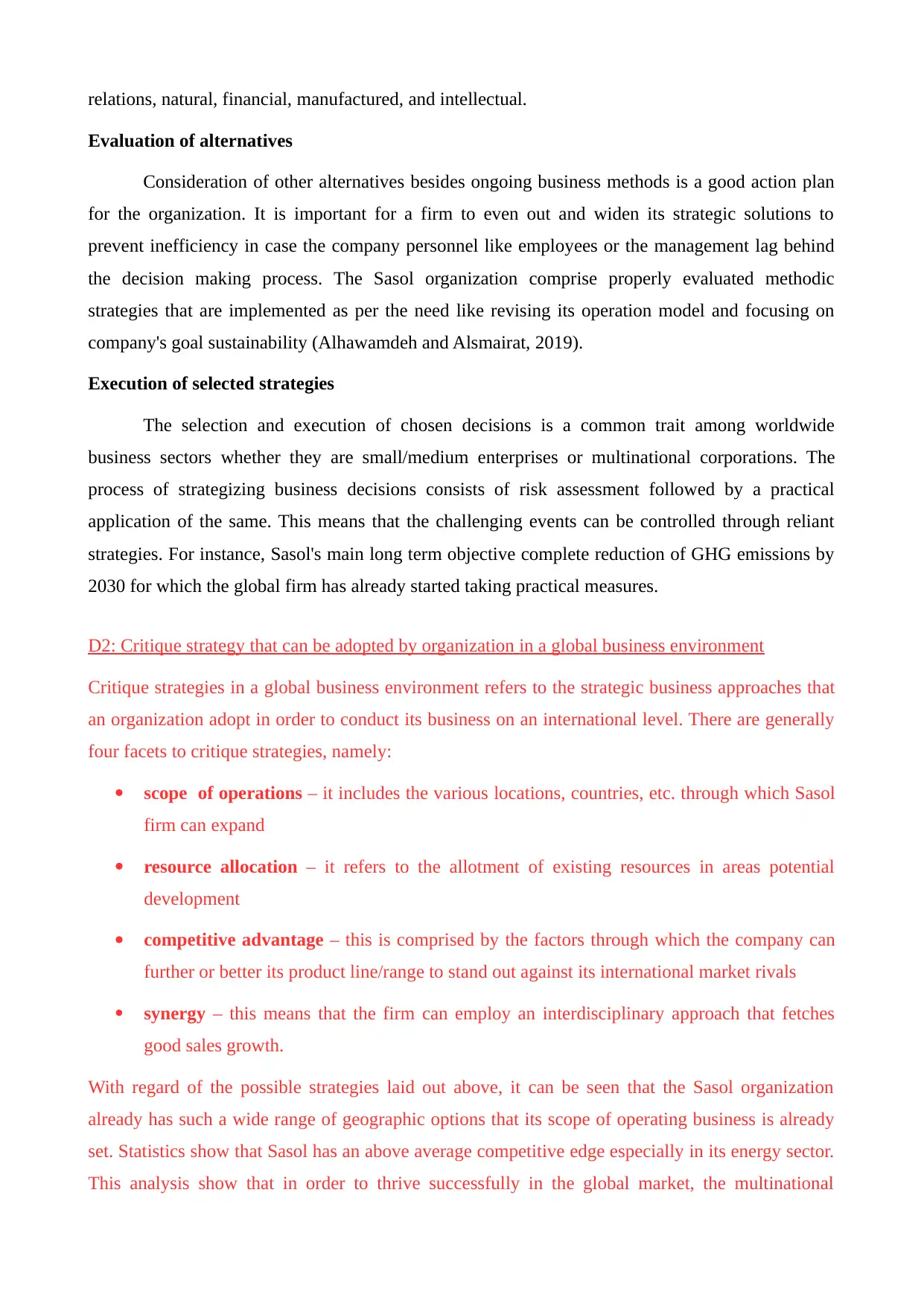
relations, natural, financial, manufactured, and intellectual.
Evaluation of alternatives
Consideration of other alternatives besides ongoing business methods is a good action plan
for the organization. It is important for a firm to even out and widen its strategic solutions to
prevent inefficiency in case the company personnel like employees or the management lag behind
the decision making process. The Sasol organization comprise properly evaluated methodic
strategies that are implemented as per the need like revising its operation model and focusing on
company's goal sustainability (Alhawamdeh and Alsmairat, 2019).
Execution of selected strategies
The selection and execution of chosen decisions is a common trait among worldwide
business sectors whether they are small/medium enterprises or multinational corporations. The
process of strategizing business decisions consists of risk assessment followed by a practical
application of the same. This means that the challenging events can be controlled through reliant
strategies. For instance, Sasol's main long term objective complete reduction of GHG emissions by
2030 for which the global firm has already started taking practical measures.
D2: Critique strategy that can be adopted by organization in a global business environment
Critique strategies in a global business environment refers to the strategic business approaches that
an organization adopt in order to conduct its business on an international level. There are generally
four facets to critique strategies, namely:
scope of operations – it includes the various locations, countries, etc. through which Sasol
firm can expand
resource allocation – it refers to the allotment of existing resources in areas potential
development
competitive advantage – this is comprised by the factors through which the company can
further or better its product line/range to stand out against its international market rivals
synergy – this means that the firm can employ an interdisciplinary approach that fetches
good sales growth.
With regard of the possible strategies laid out above, it can be seen that the Sasol organization
already has such a wide range of geographic options that its scope of operating business is already
set. Statistics show that Sasol has an above average competitive edge especially in its energy sector.
This analysis show that in order to thrive successfully in the global market, the multinational
Evaluation of alternatives
Consideration of other alternatives besides ongoing business methods is a good action plan
for the organization. It is important for a firm to even out and widen its strategic solutions to
prevent inefficiency in case the company personnel like employees or the management lag behind
the decision making process. The Sasol organization comprise properly evaluated methodic
strategies that are implemented as per the need like revising its operation model and focusing on
company's goal sustainability (Alhawamdeh and Alsmairat, 2019).
Execution of selected strategies
The selection and execution of chosen decisions is a common trait among worldwide
business sectors whether they are small/medium enterprises or multinational corporations. The
process of strategizing business decisions consists of risk assessment followed by a practical
application of the same. This means that the challenging events can be controlled through reliant
strategies. For instance, Sasol's main long term objective complete reduction of GHG emissions by
2030 for which the global firm has already started taking practical measures.
D2: Critique strategy that can be adopted by organization in a global business environment
Critique strategies in a global business environment refers to the strategic business approaches that
an organization adopt in order to conduct its business on an international level. There are generally
four facets to critique strategies, namely:
scope of operations – it includes the various locations, countries, etc. through which Sasol
firm can expand
resource allocation – it refers to the allotment of existing resources in areas potential
development
competitive advantage – this is comprised by the factors through which the company can
further or better its product line/range to stand out against its international market rivals
synergy – this means that the firm can employ an interdisciplinary approach that fetches
good sales growth.
With regard of the possible strategies laid out above, it can be seen that the Sasol organization
already has such a wide range of geographic options that its scope of operating business is already
set. Statistics show that Sasol has an above average competitive edge especially in its energy sector.
This analysis show that in order to thrive successfully in the global market, the multinational
⊘ This is a preview!⊘
Do you want full access?
Subscribe today to unlock all pages.

Trusted by 1+ million students worldwide
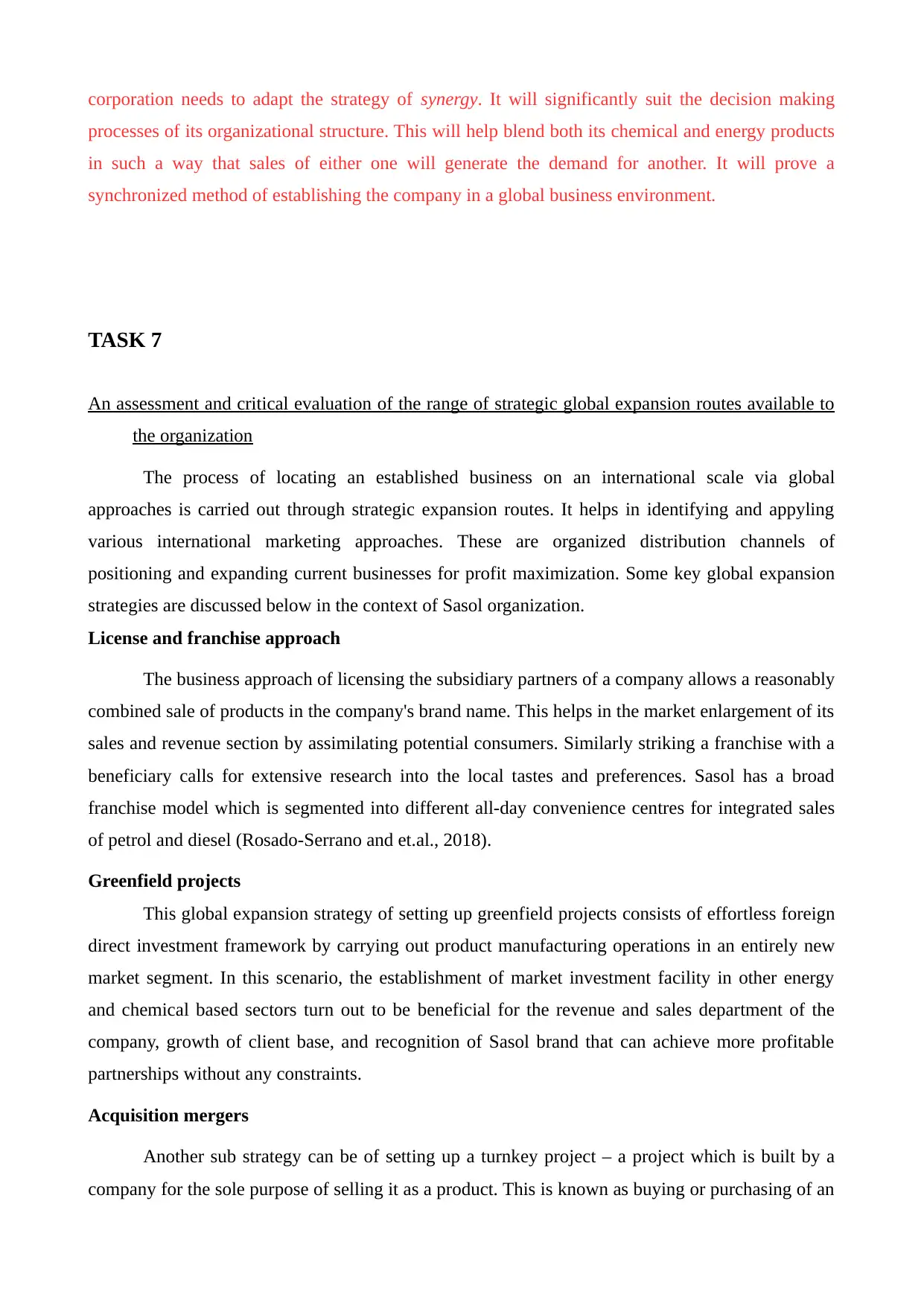
corporation needs to adapt the strategy of synergy. It will significantly suit the decision making
processes of its organizational structure. This will help blend both its chemical and energy products
in such a way that sales of either one will generate the demand for another. It will prove a
synchronized method of establishing the company in a global business environment.
TASK 7
An assessment and critical evaluation of the range of strategic global expansion routes available to
the organization
The process of locating an established business on an international scale via global
approaches is carried out through strategic expansion routes. It helps in identifying and appyling
various international marketing approaches. These are organized distribution channels of
positioning and expanding current businesses for profit maximization. Some key global expansion
strategies are discussed below in the context of Sasol organization.
License and franchise approach
The business approach of licensing the subsidiary partners of a company allows a reasonably
combined sale of products in the company's brand name. This helps in the market enlargement of its
sales and revenue section by assimilating potential consumers. Similarly striking a franchise with a
beneficiary calls for extensive research into the local tastes and preferences. Sasol has a broad
franchise model which is segmented into different all-day convenience centres for integrated sales
of petrol and diesel (Rosado-Serrano and et.al., 2018).
Greenfield projects
This global expansion strategy of setting up greenfield projects consists of effortless foreign
direct investment framework by carrying out product manufacturing operations in an entirely new
market segment. In this scenario, the establishment of market investment facility in other energy
and chemical based sectors turn out to be beneficial for the revenue and sales department of the
company, growth of client base, and recognition of Sasol brand that can achieve more profitable
partnerships without any constraints.
Acquisition mergers
Another sub strategy can be of setting up a turnkey project – a project which is built by a
company for the sole purpose of selling it as a product. This is known as buying or purchasing of an
processes of its organizational structure. This will help blend both its chemical and energy products
in such a way that sales of either one will generate the demand for another. It will prove a
synchronized method of establishing the company in a global business environment.
TASK 7
An assessment and critical evaluation of the range of strategic global expansion routes available to
the organization
The process of locating an established business on an international scale via global
approaches is carried out through strategic expansion routes. It helps in identifying and appyling
various international marketing approaches. These are organized distribution channels of
positioning and expanding current businesses for profit maximization. Some key global expansion
strategies are discussed below in the context of Sasol organization.
License and franchise approach
The business approach of licensing the subsidiary partners of a company allows a reasonably
combined sale of products in the company's brand name. This helps in the market enlargement of its
sales and revenue section by assimilating potential consumers. Similarly striking a franchise with a
beneficiary calls for extensive research into the local tastes and preferences. Sasol has a broad
franchise model which is segmented into different all-day convenience centres for integrated sales
of petrol and diesel (Rosado-Serrano and et.al., 2018).
Greenfield projects
This global expansion strategy of setting up greenfield projects consists of effortless foreign
direct investment framework by carrying out product manufacturing operations in an entirely new
market segment. In this scenario, the establishment of market investment facility in other energy
and chemical based sectors turn out to be beneficial for the revenue and sales department of the
company, growth of client base, and recognition of Sasol brand that can achieve more profitable
partnerships without any constraints.
Acquisition mergers
Another sub strategy can be of setting up a turnkey project – a project which is built by a
company for the sole purpose of selling it as a product. This is known as buying or purchasing of an
Paraphrase This Document
Need a fresh take? Get an instant paraphrase of this document with our AI Paraphraser
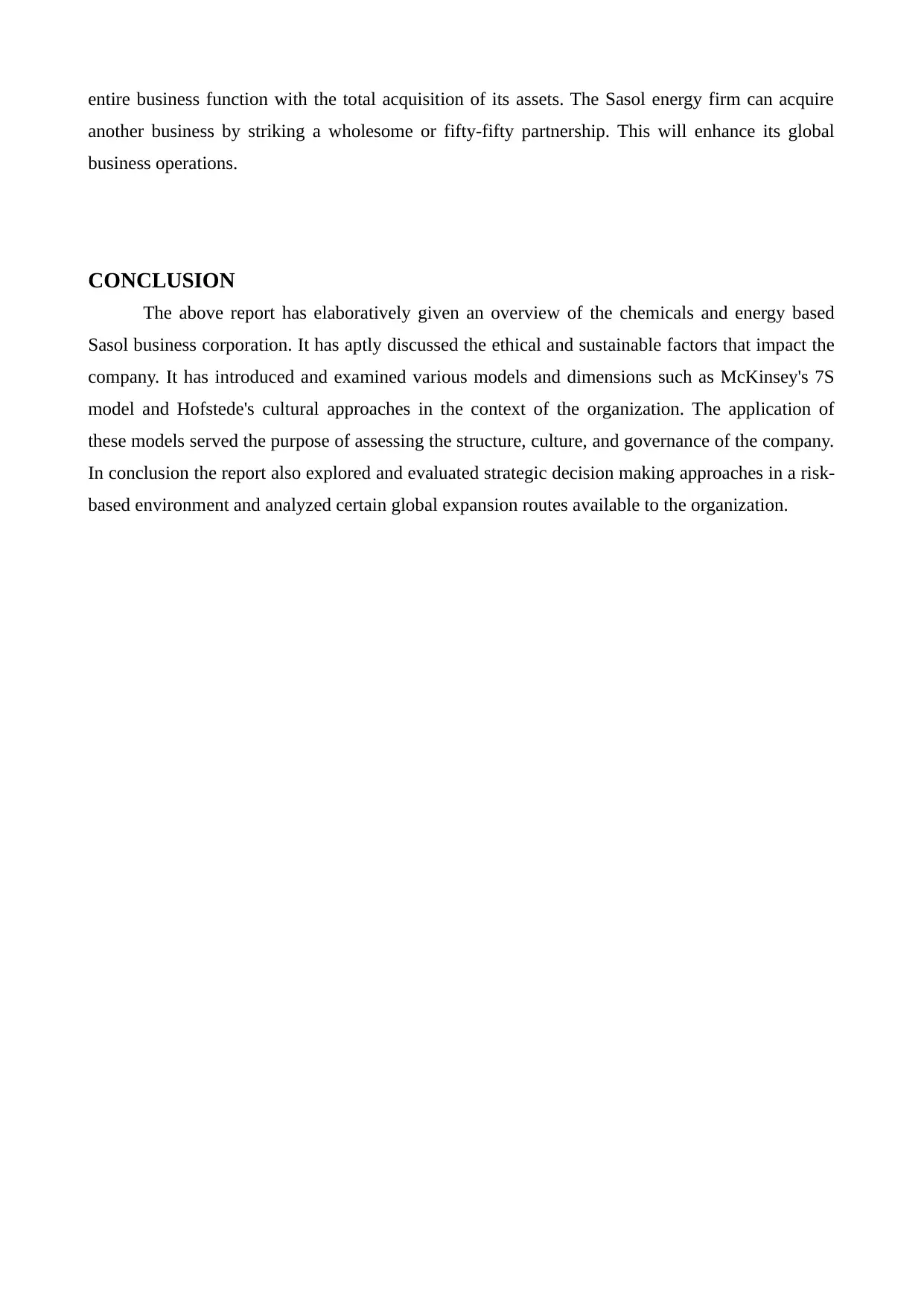
entire business function with the total acquisition of its assets. The Sasol energy firm can acquire
another business by striking a wholesome or fifty-fifty partnership. This will enhance its global
business operations.
CONCLUSION
The above report has elaboratively given an overview of the chemicals and energy based
Sasol business corporation. It has aptly discussed the ethical and sustainable factors that impact the
company. It has introduced and examined various models and dimensions such as McKinsey's 7S
model and Hofstede's cultural approaches in the context of the organization. The application of
these models served the purpose of assessing the structure, culture, and governance of the company.
In conclusion the report also explored and evaluated strategic decision making approaches in a risk-
based environment and analyzed certain global expansion routes available to the organization.
another business by striking a wholesome or fifty-fifty partnership. This will enhance its global
business operations.
CONCLUSION
The above report has elaboratively given an overview of the chemicals and energy based
Sasol business corporation. It has aptly discussed the ethical and sustainable factors that impact the
company. It has introduced and examined various models and dimensions such as McKinsey's 7S
model and Hofstede's cultural approaches in the context of the organization. The application of
these models served the purpose of assessing the structure, culture, and governance of the company.
In conclusion the report also explored and evaluated strategic decision making approaches in a risk-
based environment and analyzed certain global expansion routes available to the organization.
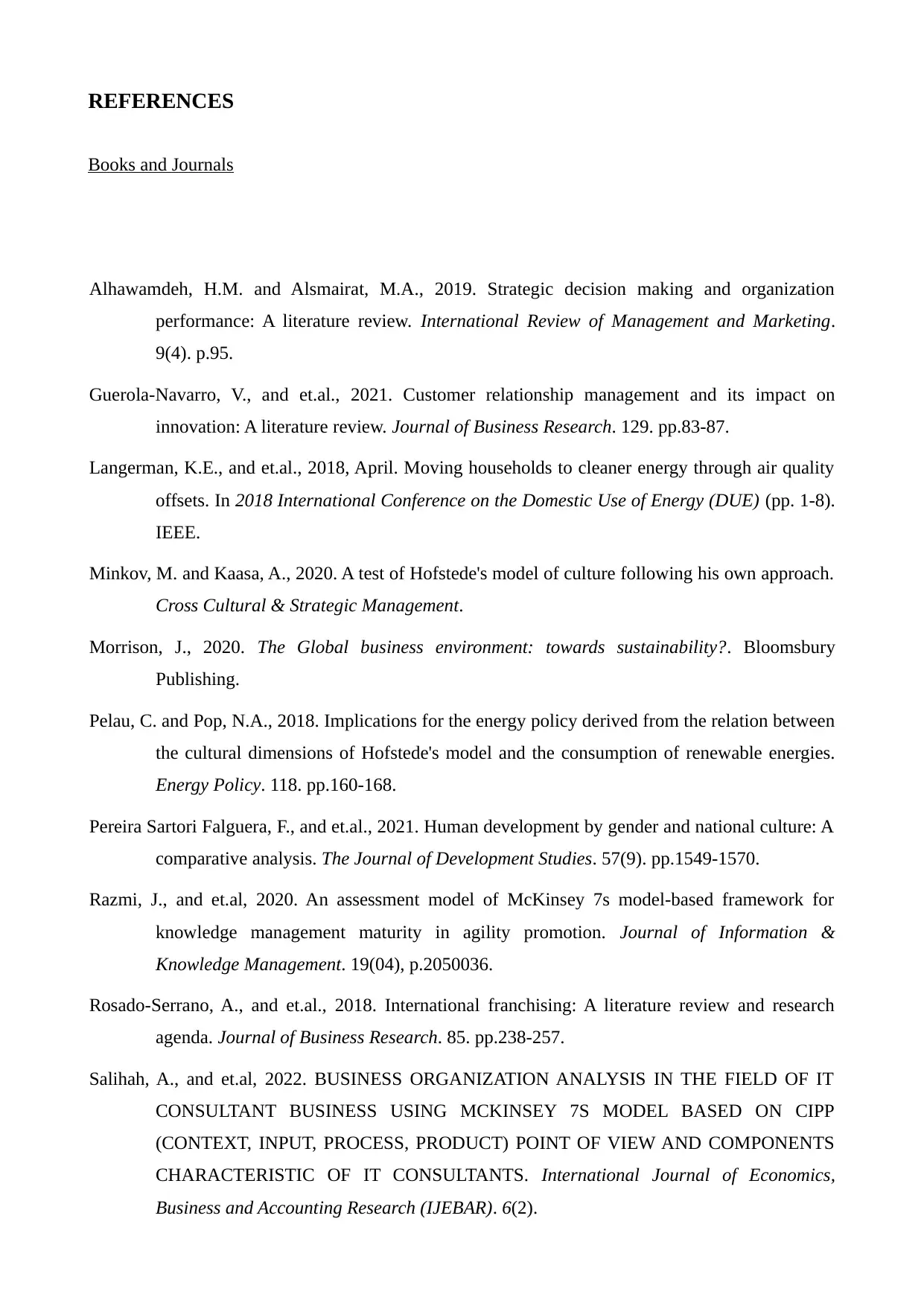
REFERENCES
Books and Journals
Alhawamdeh, H.M. and Alsmairat, M.A., 2019. Strategic decision making and organization
performance: A literature review. International Review of Management and Marketing.
9(4). p.95.
Guerola-Navarro, V., and et.al., 2021. Customer relationship management and its impact on
innovation: A literature review. Journal of Business Research. 129. pp.83-87.
Langerman, K.E., and et.al., 2018, April. Moving households to cleaner energy through air quality
offsets. In 2018 International Conference on the Domestic Use of Energy (DUE) (pp. 1-8).
IEEE.
Minkov, M. and Kaasa, A., 2020. A test of Hofstede's model of culture following his own approach.
Cross Cultural & Strategic Management.
Morrison, J., 2020. The Global business environment: towards sustainability?. Bloomsbury
Publishing.
Pelau, C. and Pop, N.A., 2018. Implications for the energy policy derived from the relation between
the cultural dimensions of Hofstede's model and the consumption of renewable energies.
Energy Policy. 118. pp.160-168.
Pereira Sartori Falguera, F., and et.al., 2021. Human development by gender and national culture: A
comparative analysis. The Journal of Development Studies. 57(9). pp.1549-1570.
Razmi, J., and et.al, 2020. An assessment model of McKinsey 7s model-based framework for
knowledge management maturity in agility promotion. Journal of Information &
Knowledge Management. 19(04), p.2050036.
Rosado-Serrano, A., and et.al., 2018. International franchising: A literature review and research
agenda. Journal of Business Research. 85. pp.238-257.
Salihah, A., and et.al, 2022. BUSINESS ORGANIZATION ANALYSIS IN THE FIELD OF IT
CONSULTANT BUSINESS USING MCKINSEY 7S MODEL BASED ON CIPP
(CONTEXT, INPUT, PROCESS, PRODUCT) POINT OF VIEW AND COMPONENTS
CHARACTERISTIC OF IT CONSULTANTS. International Journal of Economics,
Business and Accounting Research (IJEBAR). 6(2).
Books and Journals
Alhawamdeh, H.M. and Alsmairat, M.A., 2019. Strategic decision making and organization
performance: A literature review. International Review of Management and Marketing.
9(4). p.95.
Guerola-Navarro, V., and et.al., 2021. Customer relationship management and its impact on
innovation: A literature review. Journal of Business Research. 129. pp.83-87.
Langerman, K.E., and et.al., 2018, April. Moving households to cleaner energy through air quality
offsets. In 2018 International Conference on the Domestic Use of Energy (DUE) (pp. 1-8).
IEEE.
Minkov, M. and Kaasa, A., 2020. A test of Hofstede's model of culture following his own approach.
Cross Cultural & Strategic Management.
Morrison, J., 2020. The Global business environment: towards sustainability?. Bloomsbury
Publishing.
Pelau, C. and Pop, N.A., 2018. Implications for the energy policy derived from the relation between
the cultural dimensions of Hofstede's model and the consumption of renewable energies.
Energy Policy. 118. pp.160-168.
Pereira Sartori Falguera, F., and et.al., 2021. Human development by gender and national culture: A
comparative analysis. The Journal of Development Studies. 57(9). pp.1549-1570.
Razmi, J., and et.al, 2020. An assessment model of McKinsey 7s model-based framework for
knowledge management maturity in agility promotion. Journal of Information &
Knowledge Management. 19(04), p.2050036.
Rosado-Serrano, A., and et.al., 2018. International franchising: A literature review and research
agenda. Journal of Business Research. 85. pp.238-257.
Salihah, A., and et.al, 2022. BUSINESS ORGANIZATION ANALYSIS IN THE FIELD OF IT
CONSULTANT BUSINESS USING MCKINSEY 7S MODEL BASED ON CIPP
(CONTEXT, INPUT, PROCESS, PRODUCT) POINT OF VIEW AND COMPONENTS
CHARACTERISTIC OF IT CONSULTANTS. International Journal of Economics,
Business and Accounting Research (IJEBAR). 6(2).
⊘ This is a preview!⊘
Do you want full access?
Subscribe today to unlock all pages.

Trusted by 1+ million students worldwide
1 out of 13
Related Documents
Your All-in-One AI-Powered Toolkit for Academic Success.
+13062052269
info@desklib.com
Available 24*7 on WhatsApp / Email
![[object Object]](/_next/static/media/star-bottom.7253800d.svg)
Unlock your academic potential
Copyright © 2020–2025 A2Z Services. All Rights Reserved. Developed and managed by ZUCOL.




